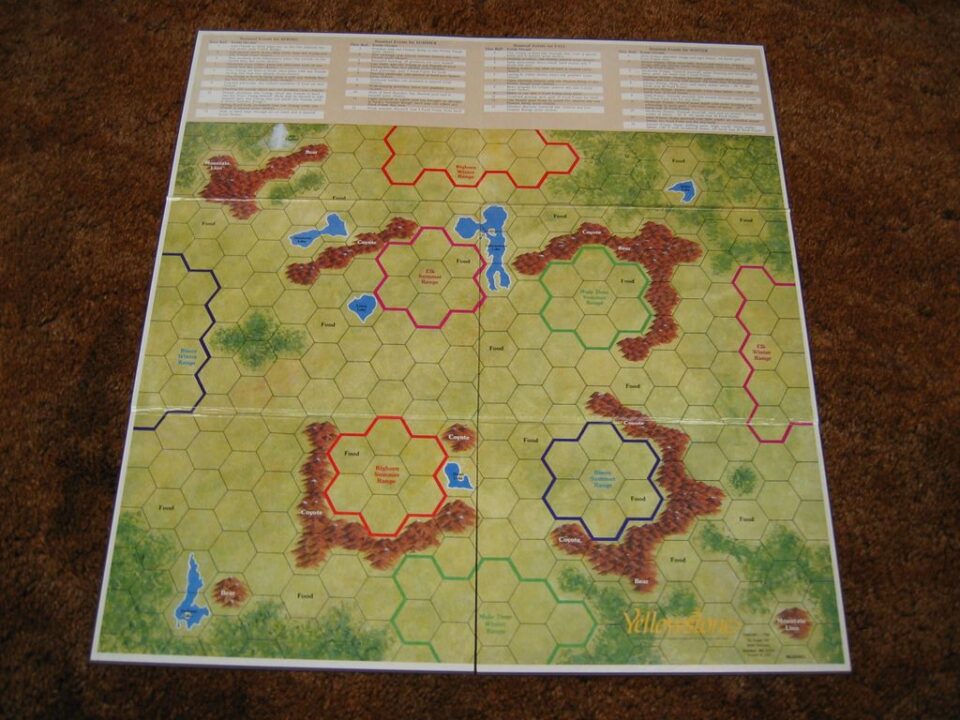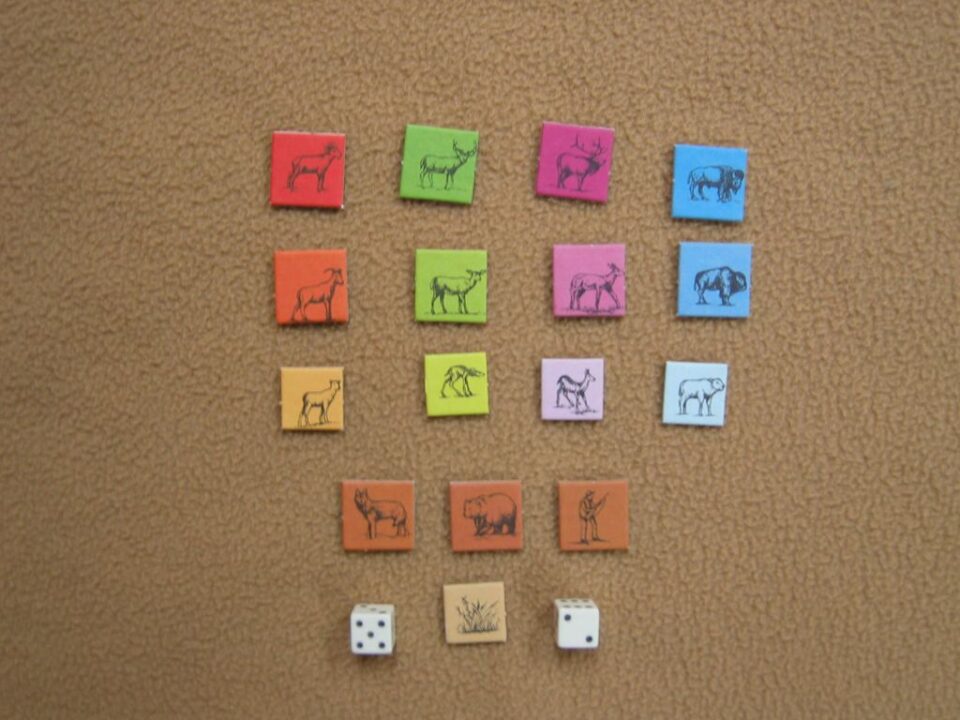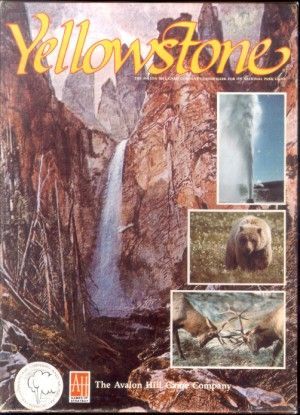If you’ve ever dreamed of wrangling bison, dodging geysers, or yelling at your friends for grabbing that last wolf you needed, you might want to stick around for this review. I’ve roped in a mixed crowd of board game veterans and noobs to test out Yellowstone, and let me tell you, we discovered more surprises than I found in my hiking boots last summer. Is this game the tabletop adventure you need, or is it just a pretty box destined for the dusty shelf? Grab your ranger hat, and let’s see if Yellowstone is worth exploring—or if it’s about as exciting as a wet sock in a tent.
How It Plays
Setting Up
First, lay out the Yellowstone board in the center of your table. Each player grabs a set of colored hiker meeples, matching tents, and a handy-dandy player guide. Shuffle the animal and resource cards, place the tokens in piles, and set the geyser marker where the rules say. Put the bear meeple close by. Warning: do not taunt the bear. (It’s just plastic, but still.)
Gameplay
On your turn, you’ll pick actions like moving your hikers, gathering resources, or claiming a scenic site. You can also try to shoo away rivals with the bear—perfect for people who love a bit of friendly sabotage. Keep an eye on your resources and tents because clever planning will get you more points than just wandering about. Expect a bit of table banter as people argue over the best waterfall view.
Winning the Game
Once the geyser marker signals the game’s end, everyone tallies their points. You score for sites you’ve claimed, animals you spotted, and bonus cards. Whoever has the most points wins bragging rights as Yellowstone’s ultimate hiker—trust me, this will come up every game night for weeks.
Want to know more? Read our extensive strategy guide for Yellowstone.
The Theme and Visual Appeal of Yellowstone: A Tour for the Eyes
Let me start by saying, Yellowstone’s box art alone made me feel like I should be wearing a park ranger hat while opening it. The game oozes national park charm from every corner—and believe me, there are a lot of corners. When I set it up, my friend Mike said, “Wow, I want to pitch a tent right on the board!” I’m not sure Mike’s ever been camping, but that’s how gorgeous Yellowstone looks on the table.
Each board tile, card, and meeple looks like it just stepped out of a high-end travel magazine. The colors pop in a way that even my colorblind buddy said, “I think I can see all the animals!” The wildlife tokens are chunky and satisfying to move. The river tiles twist and turn in a way that calls to mind an actual park map—if your park map got a professional makeup artist.
But it’s not just pretty pictures tossed on cardboard. The artwork actually helps you get into the spirit of Yellowstone. I kept humming John Denver while I played, and I don’t even like John Denver. The designers clearly love the park, and they want you to love it too. They sprinkle little details everywhere, from the geysers erupting on the edge of your board to the bear pawprints leading the way. If you’re a fan of nature, it’s hard not to grin as you play.
Still, while everything looks amazing, I do think there’s a lot going on visually. The table gets a bit crowded, especially if you’re fighting for space with snacks and drinks (which, let’s be honest, you are). Sometimes, the fancy font on the cards got a few laughs from us as we tried to guess the actual animal names.
Anyway, enough about the pretty bits—next up, we’re getting our hands dirty with Gameplay Mechanics and Strategy. Hope you brought your hiking boots!

Yellowstone’s Gameplay Mechanics and Strategy: Herding Bison or Herding Cats?
Let’s talk about how Yellowstone actually plays, which is everyone’s real question after they’ve finished gawking at the bison meeples. This isn’t a game where you just move a pawn and cross your fingers. Nope, Yellowstone is all about smart movement, resource management, and the kind of planning that makes you feel like you should have a ranger’s badge by the end.
Each turn, you pick actions like trekking across the board, collecting resources (like wood, stone, or the rare but always welcome geyser token), and trying to complete secret objectives before your sneaky friends do. There’s a shared pool of resources, so if you snooze, you literally lose—the best spaces go faster than a geyser at noon. I found myself squabbling with Greg over who gets to claim Old Faithful, which is probably the closest we’ll ever get to real park politics.
Strategy in Yellowstone feels just deep enough to make you think but not so heavy it fries your brain. If you like plotting your turns, weighing risks, and watching your plans come together (or go up in flames), you’re in for a treat. But watch out: there’s a sprinkle of randomness with the event cards, and I would’ve liked a little less luck. Still, clever players can outmaneuver a bad draw, and that’s where true park legends are made.
Before I get lost in the wilderness, let’s trek over to the next section—Player Interaction and Engagement—where things get a little wild (and sometimes personal) at the game table!

Does Yellowstone Make You Want to Talk to Your Friends?
Yellowstone isn’t just about collecting cute bison meeples and pretending you know stuff about geysers. It gives plenty of reasons to actually engage with your friends, for better or worse. I say ‘for better or worse’ because sometimes I love my friends and sometimes, after a round of Yellowstone, I want to throw them into Old Faithful. In a loving way, of course.
There’s just something about Yellowstone’s park management theme that gets people talking. It’s not just about winning – it’s about trying to out-smart your pals, blocking their perfect trail, or nabbing the last hiking permit they desperately need. The board is tight, and the choices get personal fast. If you think you’re just building your own peaceful wilderness, think again. My sincere condolences to anyone who can’t handle a little friendly sabotage.
On top of that, the event cards stir up drama. When someone triggers a wildfire or an unexpected animal migration, jaws drop. I lost a whole turn thanks to a rogue card and my friends’ laughter still haunts me. But honestly, the table talk is what makes Yellowstone memorable. Pleading, plotting, scheming over who should get the next ranger or what area to secure – it’s all here. Even the quietest players in my group got swept up, secretly rooting for each other while feigning polite rivalry.
Yellowstone’s player interaction isn’t just baked in; it’s the secret sauce. Whether you’re gunning for the most scenic views or sabotaging your so-called best mate’s plans, you’ll find plenty of laughs and groans. Next, I’ll reveal if this epic park adventure is worth visiting over and over – plus, if the components survive a hungry dog!
Replay Value and Component Quality in Yellowstone: Can You Keep Coming Back for More?
Listen, if I’m going to drag my friends to the table for Yellowstone yet again (usually with the promise of pizza), the game better give us a new experience each time. I want value for my money. Good news: this park packs some serious replay value into its box. There are different setup layouts, variable objectives, and a bunch of strategies to try on your next romp through the geysers and bison stampedes. After five games, I still didn’t feel like I’d seen every trick. My friend Tim kept insisting he’d found the winning formula, until the next game blew up in his face. Sweet, sweet karma.
But a game isn’t just about what’s on the inside, it’s about how it feels to play. Let’s talk components. The Yellowstone production quality is, honestly, a treat. The tiles are thick and satisfying to plop onto the table (they make a nice clunk, which is a weirdly satisfying sound). The animal meeples are so adorable you almost feel bad about sending them off to do your dirty work. The cards are sturdy—helpful for when your friend knocks over a glass of root beer mid-game (yes, this happened). And the artwork? It’s not just pretty, it’s National-Park-postcard-perfect. My only nitpick: the insert feels like someone forgot board gamers like things organized. It’s not a box disaster, but it could use some work.
If you like a game that keeps you guessing and looks great on your table, Yellowstone is a strong pickup. I’ll forgive the insert (barely) because everything else is a joy. Recommendation: Hike, don’t stroll, to your FLGS and grab it.
Conclusion
And there you have it, folks! That’s my full roundup on Yellowstone. It’s a gorgeous game that nails its US national park theme, and it looks stunning on any table. Strategic choices matter, and there’s just enough player interaction to keep things spicy, but not so much you’ll want to flip the table (okay, except maybe that one time Joe blocked my perfect trail—Joe, you know what you did). Luck plays a small part, but skill wins the day. The replay value is strong, and the pieces feel premium. My only gripe? The box insert is about as useful as a chocolate teapot. Still, that’s a tiny blip on an otherwise fantastic game. If you’re after a midweight strategy game that’s equal parts beauty and brains, Yellowstone is a keeper. Grab your ranger hat and gather your friends—you’ll have a wild time. Thanks for sticking with me through the review, and may your next board game night be grizzly-free!


